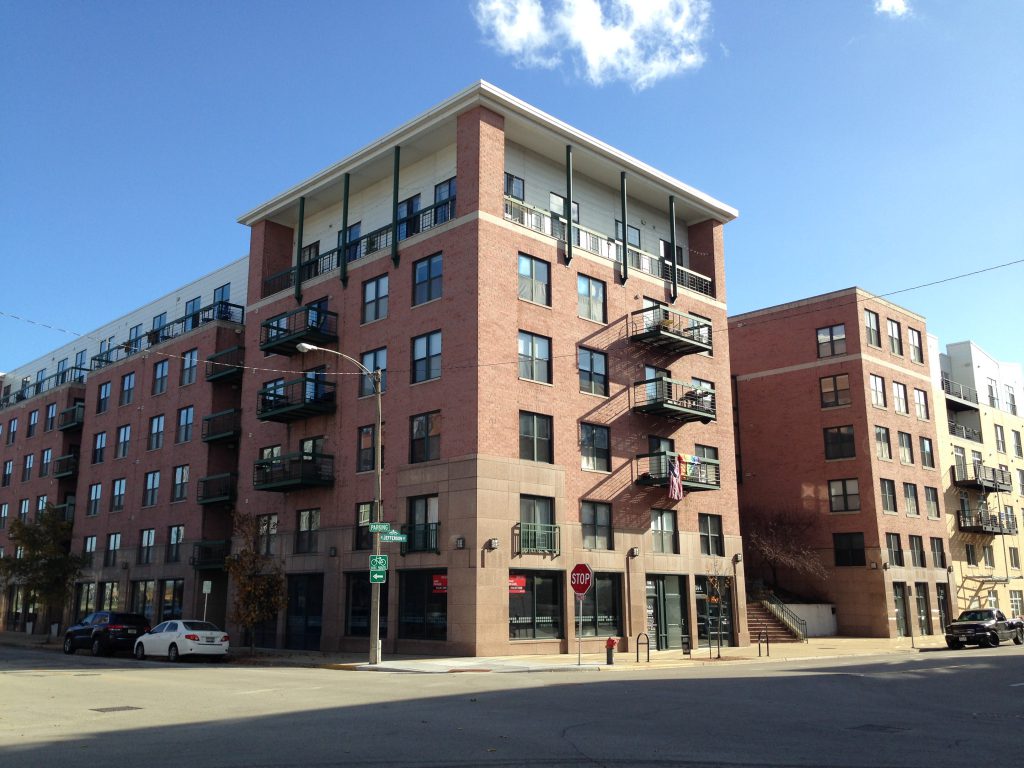Rent Down 1% Locally Since Start of Pandemic
Rent prices had originally increased as pandemic took hold, but are now falling.

Jefferson Block Apartments, 144 N. Jefferson St. Photo by Mariiana Tzotcheva.
Residential rent prices are down 1% since March according to a new report from Apartment List, a property listing website.
That’s good news for renters and in sharp contrast to the company’s August report, when Milwaukee rents had grown by 0.7% since March as the pandemic appeared to be increasing demand in a number of mid-sized cities.
San Francisco leads the pack with a 26.7% decline. Milwaukee neighbors Chicago (13.2%) and Minneapolis (12.8%) also appear in the top 10 list for biggest declines. Other formerly hot, coastal markets make the biggest loser list, including New York City and Seattle.
Some cities have seen rent prices increase since the pandemic began, led by Boise (9.7%). Four of the top 10 cities are in California, but none are the state’s premier cities. Fresno leads the Golden State cohort with a 7.9% increase since March.
“Expensive coastal cities such as San Francisco, Seattle, and New York City are continuing to see rents fall rapidly, while traditionally affordable mid-sized cities such as Boise have actually become more expensive over the course of the pandemic,” wrote the report authors Chris Salviati, Igor Popov and Rob Warnock.
According to data from Apartment List, the median one-bedroom apartment in Milwaukee rents for $737, a two-bedroom unit for $905.
Rental prices fell 0.2% in Milwaukee over the past month, while the national average fell 0.4%. The listing service attributes the recent decline to a seasonal variation it has seen in each of the past three years, albeit slightly steeper. Prices began rising as temperatures increased in years prior.
Data is not available for Milwaukee suburbs, but the company reports that rents in Madison are down 0.1% since March and climbed 0.4% in the past month.
“Vacancy data from our online marketplace help explain the strong regional divides described throughout this report. The pandemic has led to more vacancies in some cities and fewer in others, as renters have new budgets and new housing preferences,” wrote the authors.
The pandemic could continue to bring more change to the rental market.
A second report from the organization, centered on renter survey results, says that 28% of renters entered 2021 with unpaid rent bills from prior months. That’s down from 33% in October.
The problem is greater amongst minority communities. Based on survey data, 53% of Black renters reported having unpaid rent bills, followed by 38% of Hispanic renters, 27% of Asian renters and 21% of white renters.
Black renters reporting unpaid bills jumped from 47% to 53% since the October survey, while Hispanic renters reporting unpaid bills fell from 56% to 38%.
A National Multifamily Housing Council report says that 21.7% of households made a full or partial rental payment over the first six days of January 2020 and that the rate fell by 1.7 percentage points in the same period of 2021.
The survey relied on more than 4,000 responses balanced by gender and age to match the national distribution.
To calculate the rental statistics Apartment List uses data from the US Census Bureau and transaction price estimates and makes comparisons between units available in both sample periods to filter out new, high-end housing being introduced. It previously relied on listing data, but switched to transaction data in September in an attempt to produce a more accurate representation and better understand factors like seasonal changes.
If you think stories like this are important, become a member of Urban Milwaukee and help support real, independent journalism. Plus you get some cool added benefits.
More about the Coronavirus Pandemic
- Governors Tony Evers, JB Pritzker, Tim Walz, and Gretchen Whitmer Issue a Joint Statement Concerning Reports that Donald Trump Gave Russian Dictator Putin American COVID-19 Supplies - Gov. Tony Evers - Oct 11th, 2024
- MHD Release: Milwaukee Health Department Launches COVID-19 Wastewater Testing Dashboard - City of Milwaukee Health Department - Jan 23rd, 2024
- Milwaukee County Announces New Policies Related to COVID-19 Pandemic - County Executive David Crowley - May 9th, 2023
- DHS Details End of Emergency COVID-19 Response - Wisconsin Department of Health Services - Apr 26th, 2023
- Milwaukee Health Department Announces Upcoming Changes to COVID-19 Services - City of Milwaukee Health Department - Mar 17th, 2023
- Fitzgerald Applauds Passage of COVID-19 Origin Act - U.S. Rep. Scott Fitzgerald - Mar 10th, 2023
- DHS Expands Free COVID-19 Testing Program - Wisconsin Department of Health Services - Feb 10th, 2023
- MKE County: COVID-19 Hospitalizations Rising - Graham Kilmer - Jan 16th, 2023
- Not Enough Getting Bivalent Booster Shots, State Health Officials Warn - Gaby Vinick - Dec 26th, 2022
- Nearly All Wisconsinites Age 6 Months and Older Now Eligible for Updated COVID-19 Vaccine - Wisconsin Department of Health Services - Dec 15th, 2022
Read more about Coronavirus Pandemic here
Eyes on Milwaukee
-
Church, Cupid Partner On Affordable Housing
 Dec 4th, 2023 by Jeramey Jannene
Dec 4th, 2023 by Jeramey Jannene
-
Downtown Building Sells For Nearly Twice Its Assessed Value
 Nov 12th, 2023 by Jeramey Jannene
Nov 12th, 2023 by Jeramey Jannene
-
Immigration Office Moving To 310W Building
 Oct 25th, 2023 by Jeramey Jannene
Oct 25th, 2023 by Jeramey Jannene


















